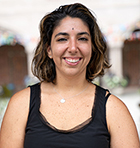
Dr. Stephanie Spera
-
Profile
Stephanie Spera's research seeks to understand landscape-level human-environment feedbacks with regard to social, economic, and environmental drivers and consequences. She analyzes large datasets, develops algorithms, and integrates spatial data to characterize landscapes and landscape-scale dynamics. Her skillset includes a strong foundation in environmental sciences, but she integrates tools and methods from other disciplines to understand how we can best manage our landscapes. Her interdisciplinary training and methodologies allow her to speak across traditional disciplinary lines and focus work on different ecosystems. She collaborates with ecologists, climate scientists, sociologists, and economists to analyze the regional socioeconomic drivers and environmental consequences of land-use change. Her research tackles pressing environmental issues and generates robust scientific results that inform policy.
Broadly, she asks, ‘How do we ensure that we manage our landscapes sustainably?’ She is interested in how and to what extent humans are modifying the landscape; what is driving changes in land cover; how these changes are affecting the environment; and how humans are, in turn, responding to these changes.
Her most recent work focuses on answering these questions focusing on agricultural land-use change and regional climate dynamics in the Brazilian Cerrado, a biodiveristy hotspot and agricultural breadbasket.Expand All-
Grants and Fellowships
Neukom Institute for Computational Science Postdoctoral Fellowship
Brown/Wheaton Faculty Fellowship
Institute at Brown for Environment and Society Graduate Fellowship
Institute at Brown for Environment and Society Graduate Research & Travel Grant
Brown University First Year Graduate Fellowship
-
Awards
2016: Brown/Wheaton Faculty Fellow
2012, 2013: NSF Graduate Research Fellowship Program, Honorable Mention
-
Presentations
2017
Sacrifice Zone or Sustainable Agricultural Powerhouse: The Brazilian Cerrado. September 19. Bates College, Lewiston, ME. (Invited)
The Drivers of Sugarcane Expansion in Goiás, Brazil. April 7. American Association of Geographers Annual Meeting, Boston, MA.
Quantifying Two Decades of Expansion of Commercial Tropical Agriculture in Brazil. April 4. International Food Security Symposium: Commercial Agriculture in the Tropical Environments, University of Illinois, Urbana-Champagne, IL. (Invited)2016
Land-Use Change and Its Effects on Regional Climate in the Brazilian Cerrado. September 29. Lyndon State College, Lyndon, VT. (Invited)2015
The Expansion of Agriculture and Its Effects on Evapotranspiration in Brazil’s Newest Agricultural Frontier. December 14. American Geophysical Union Fall Meeting, San Francisco, CA.
Examining Brazil’s Agricultural Frontier. February 20. The Gund Institute for Ecological Economics, University of Vermont, Burlington, VT. (Invited)2014
Mapping Large-Scale Mechanized Agriculture Across the Brazilian Cerrado Between 2001-2013. Poster. December 17. American Geophysical Union Fall Meeting, San Francisco, CA.
Examining Brazil’s Agricultural Frontier. December 1. Yale Center for Earth Observation, Yale University, New Haven, CT. (Invited)
Quantifying and Assessing Land Use and Land Cover Change Dynamics in a Global Breadbasket. Poster. March 19.
Second Global Land Project Open Science Meeting, Berlin, Germany.2013
Climate Variability is Influencing Agricultural Expansion and Output in a Key Agricultural Region of Brazil. Poster. December 12. American Geophysical Union Fall Meeting, San Francisco, CA.
Characterizing Land Cover in a Global Breadbasket: Land Use Dynamics in Mato Grosso State, Brazil. November 8. Brown-Marine Biological Laboratory Retreat and Symposium. Providence, RI. (Invited)
Initial Work Towards Determining The Causes and Consequences of Land Use Transitions in the Cerrado. June 27. Universidade Federal de Goiás, Goiania, Goiás State, Brazil. (Invited)
Methods and dynamics of double cropping in Mato Grosso. April 9. Association of American Geographers Annual Meeting, Los Angeles, CA.
Temporal and Spatial of Double Cropping. January 15. Intensifying Agriculture: Environmental Impacts and Potential Solutions, Marine Biological Laboratory, Woods Hole, MA.
-
Grants and Fellowships
-
Publications
Journal Articles
Spera SA, Winter JM, Chipman J. (2018) The Influence of Agricultural Land Cover Representations on Regional Climate Model Simulations in the Brazilian Cerrado. Journal of Geophysical Research: Atmospheres. In print.
Spera SA. (2017) Agricultural intensification can preserve the Brazilian Cerrado: Applying lessons from Mato Grosso and Goiás to Brazil’s last agricultural frontier. Tropical Conservation Science, 10, 1-7.
Parker, CL, Lynch AH, Spera SA, Spangler KR. (2017) The Relationship between Tropical Cyclone Activity, Nutrient Loading, and Algal Blooms over the Great Barrier Reef. Biogeosciences Discussions.
Roy ED, Willig E, Richards PD, Martinelli LA, Vazquez FF, Pegorini F, Spera SA, Porder S. (2017) Soil phosphorus sorption capacity after three decades of intensive fertilization in Mato Grosso, Brazil. Agriculture, Ecosystems & Environment, 249C, 206-2015.
Spera SA, VanWey LK, Mustard JF. (2017) Drivers of Sugarcane Expansion in Goiás, Brazil. Land Use Policy, 66, 111-119.
Spangler KR, Lynch AH, Spera SA. (2017) Precipitation-Related Drivers of Cropping Frequency in the Brazilian Cerrado: Evidence and Implications for Decision-Making. Weather, Climate and Society, 9, 201-213.
Spera SA, Galford GL, Coe MT, Macedo MN, Mustard JF (2016) Land-Use Change Affects Water Recycling in Brazil’s Last Agricultural Frontier. Global Change Biology, 22, 3405-3413.
Roy ED, Richards PD, Martinelli LA, Coletta LD, Lins SRM, Vazquez FF, Willig E, Spera SA, VanWey LK, Porder S (2016) The phosphorus cost of agricultural intensification in the tropics, Nature Plants, 2: 16043.
Cohn A, VanWey LK, Spera SA, Mustard JF (2016) Cropping frequency and area response to climate variability can exceed yield response, Nature Climate Change, 6, 601-604.
Richards P, Pellegrina H, VanWey L, Spera SA (2015) Soybean Development: The Impact of a Decade of Agricultural Change on Urban and Economic Growth in Mato Grosso, Brazil, PLoS One, 10(4): e0122510.
Spera SA, Cohn A, Mustard J, Rudorff B, VanWey L, Risso J, Adami M (2014) Recent cropping frequency, expansion, and abandonment in Mato Grosso, Brazil had selective land characteristics. Environmental Research Letters, 9: 065010.
VanWey LK, Spera SA, de Sa R, Mahr D, Mustard JF (2013) Socioeconomic Development and Agricultural Intensification in Mato Grosso. Philosophical Transactions of the Royal Society B, 368(1619): 20120168.